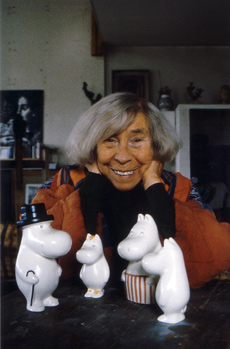Tag: children’s books
A light shining
28 July 2011 | Essays, Non-fiction
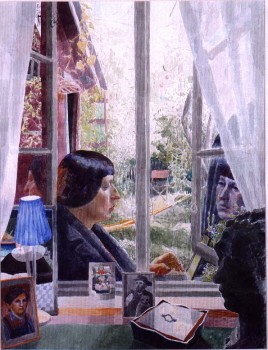
Portrait of the author: Leena Krohn, watercolour by Marjatta Hanhijoki (1998, WSOY)
In many of Leena Krohn’s books metamorphosis and paradox are central. In this article she takes a look at her own history of reading and writing, which to her are ‘the most human of metamorphoses’. Her first book, Vihreä vallankumous (‘The green revolution’, 1970), was for children; what, if anything, makes writing for children different from writing for adults?
Extracts from an essay published in Luovuuden lähteillä. Lasten- ja nuortenkirjailijat kertovat (‘At the sources of creativity. Writings by authors of books for children and young people’, edited by Päivi Heikkilä-Halttunen; The Finnish Institute for Children’s Literature & BTJ Kustannus, 2010)
What is writing? What is reading? I can still remember clearly the moment when, at the age of five, I saw signs become meanings. I had just woken up and taken down a book my mother had left on top of the chest of drawers, having read to us from it the previous day. It was Pilvihepo (‘The cloud-horse’) by Edith Unnerstad. I opened the book and as my eyes travelled along the lines, I understood what I saw. It was a second awakening, a moment of sudden realisation. I count that morning as one of the most significant of my life.
Learning to read lights up books. The dumb begin to speak. The dead come to life. The black letters look the same as they did before, and yet the change is thrilling. Reading and writing are among the most human of metamorphoses. More…
Tove Jansson meets Lewis Carroll
27 May 2011 | In the news
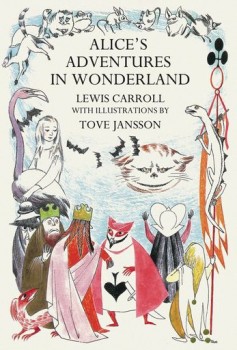 The British art museum Tate has recently reprinted two of Lewis Carroll’s books with illustrations by Tove Jansson, artist, writer and creator of the Moomins.
The British art museum Tate has recently reprinted two of Lewis Carroll’s books with illustrations by Tove Jansson, artist, writer and creator of the Moomins.
Tove Jansson (1914–2001) had begun to write and illustrate her Moomin stories for children in the late 1940s. In 1959 she was commissioned to illustrate the Swedish-language translation of Lewis Carroll’s The Hunting of the Snark (1874), about an ‘inconceivable creature’, the Snark, for the Finland-Swedish publisher Schildts.
After illustrating The Hobbit by J.R.R. Tolkien in 1962, Jansson then took on Carroll’s best-known book, Alice‘s Adventures in Wonderland, which was published in 1966 (see the pictures here).
The English-language original of Alice with her illustrations was then published in 1977 by Delacorte Press. Tate has now made Tove Jansson’s witty, perceptive visions of Alice available again, while the Snark with her original illustrations has now been printed in English for the first time.
Sari Peltoniemi: Kissataksi [Cat taxi]
4 February 2011 | Mini reviews, Reviews
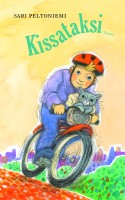 Kissataksi
Kissataksi
[Cat taxi]
Kuvitus [ill. by]: Liisa Kallio
Helsinki: Tammi, 2010. 154 p.
ISBN 978-951-31-5243-7
€16, hardback
Children’s novels with a humane, everyday approach like that of Kissataksi are few and far between. Juho is a skinny eight-year-old boy with a perfect life: pleasant parents, a nice little brother and a dog called Rekku. But one day, he comes across seven cats and an old biddy – and find that the cats have a plan to alleviate her gloom. Juho finds himself driving a taxi for the cats, who are searching for a reliable carer for their mistress, and soon Juho is joined by Virsu, a punk girl. Kissataksi charms the reader with its genial child’s pace. Understanding of displaced people, and empathy in general, have been sadly lacking in children’s literature in recent years. The title of this book is a homage to the Japanese master animator Hayao Miyazaki’s film My Neighbour Totoro, in which a cat bus figures significantly. As in Peltoniemi’s previous novels for children and young people, there is a pinch of magic in this book.
Translated by Ruth Urbom
Reetta Niemelä & Salla Savolainen: Sinisen kärpäsen sirkus ja muita runoja [The blue fly circus and other poems]
3 February 2011 | Mini reviews, Reviews
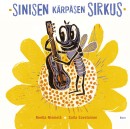 Sinisen kärpäsen sirkus ja muita runoja naapurinötököistä
Sinisen kärpäsen sirkus ja muita runoja naapurinötököistä
[The blue fly circus and other poems about neighbourhood creepy-crawlies]
Kuvitus [Ill. by]: Salla Savolainen
Helsinki: Otava, 2010. 40 p.
ISBN 978-951-1-24002-0
€20, hardback
Reetta Niemelä has provided a breath of fresh air in Finnish children’s poetry with her collections Makkarapiruetti (‘Sausage pirouette’, 2005) and Kakaduu (‘Cockatooo’, 2009), whose onomatopoeic sounds and whimsical grammar are reminiscent of children’s language play as they learn to speak. This book opens up the secrets of the world of earthworms and the tiniest of insects to the reader, revealing natural wonders at (literally) grass-roots level. The most delightful aspect, however, is to be found in its illustrations: Salla Savolainen employs a painstaking, richly nuanced woodcut technique, which puts a natural finishing touch to the collection. This sort of delicacy has not been seen in children’s book illustration in a very long time! Savolainen’s images seem light, breezy and lively – each little bug has its own charismatic personality.
Translated by Ruth Urbom
Timo Parvela & Jussi Kaakinen: Taro maan ytimessä [Taro at the centre of the Earth]
3 February 2011 | Mini reviews, Reviews
 Taro maan ytimessä
Taro maan ytimessä
[Taro at the centre of the Earth]
Kuvitus [Ill. by]: Jussi Kaakinen
Helsinki: WSOY, 2010. 24 p.
ISBN 978-951-0-36718-6
€22, hardback
Illustrator Jussi Kaakinen (born 1978) is known for, among other things, his illustrations for the graphic novel version of Risto Isomäki’s sci-fi work Sarasvatin hiekkaa (‘The sands of Sarasvati’, 2008) and two children’s non-fiction books, Suomen lasten historia (‘A Finnish children’s history’, 2005) and Suomen lasten taidehistoria (‘A Finnish children’s art history’, 2009). Taro maan ytimessä is his first picture book in his own right. Kaakinen employs an experimental illustration style here, borrowing from comic book techniques, to create an appropriately fast-paced text. The children in the story are curious to find out whether they can dig deep enough in their sandbox to reach the other side of the world. Taro has a bear for a friend who constructs a machine out of old junk that can dig into the Earth and then into outer space. On their daredevil journey, the pair encounter a greedy monster worm with a sweet tooth. Their adventure ends when Taro returns home, although the space worm, making a racket in the sewers, ought to be hidden from his parents…. Taro maan ytimessä is a pacey, visually striking adventure that will be especially enthralling to boys.
Translated by Ruth Urbom
Petra Heikkilä: Pikku Nunuun löytöretki [Little Nunuu’s treasure hunt]
1 February 2011 | Mini reviews, Reviews
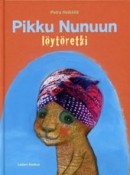 Pikku Nunuun löytöretki
Pikku Nunuun löytöretki
[Little Nunuu’s treasure hunt]
Helsinki: Lasten keskus, 2010. 32 p., ill.
ISBN 978-951-627-829-5
€23.50, hardback
Petra Heikkilä (born 1976) is a visual artist and author. Her debut title, an illustrated children’s book entitled Mikko Kettusen pupupöksyt (‘Micky Fox’s bunny pants’, 2001), was nominated for the Finlandia Junior prize in 2001. Heikkilä’s practice of portraying children as animal characters is based on their facial expressions – particularly their luminous eyes. Typical features of all eight of her picture books published so far include a warm sense of humour, wordplay and the use of collage techniques in the illustrations. At the centre of this tale set in Africa is a kanga cloth, which can be twisted and wound in a variety of ways, and Nunuu, a little lion girl who learns about the inventive uses for kanga. The rich image textures utilise collage and photographs, as well as characters painted on Ugandan barkcloth.
Translated by Ruth Urbom
Liisa Kallio: Pikku Papu [Little Papu]
31 January 2011 | Mini reviews, Reviews
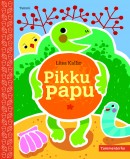 Pikku Papu
Pikku Papu
[Little Papu]
Kuvitus [Ill. by]: Liisa Kallio
Helsinki: Tammi, 2010. 31 p.
ISBN 978-951-31-5242-0
€10.30, hardback
In 2009, Finnish publisher Tammi launched its Tammenterho (‘Acorn’) series of picture books written by established Finnish authors to run along its Tammen Kultaiset kirjat (Tammi Golden Books series, modelled after a US imprint dating back to the 1940s). Pikku Papu is a jolly wandering tale for the smallest children. Papu the Tortoise notices that his shell, which he left on the beach while he went for a swim, has shrunk. In his search for a solution to his problem, he encounters a number of animals. Papu tries to cover himself with a glove he finds on the beach, but it proves to be too warm, and an eggshell he is given by a bird cracks. Fortunately, of course, everything works out in the end. This gentle story lets children identify colours and shapes and recognise various animals. The collage illustrations are attractive, and the text is simple, calmly told and appropriately short.
Translated by Ruth Urbom
Tapani Bagge: Maalla [In the country]
31 January 2011 | Mini reviews, Reviews
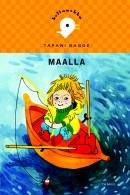 Maalla
Maalla
[In the country]
Kuvitus [ill. by]: Hannamari Ruohonen
Helsinki: Tammi, 2010. 64 p.
ISBN 978-951-31-4748-8
€9.50, hardback
There have been plenty of books for beginning readers with action-packed plots full of breathtaking twists and turns. Fortunately there are still books that leave room for a more ‘easy does it’ reading style. One of them is this, the sixth title in Tapani Bagge’s series about a girl called Kaisa. Kaisa travels to the countryside with her father and her father’s partner Sirkka. Their journey is overshadowed by the death of Kaisa’s grandmother, and the little girl believes that nothing at her grandma’s place will ever be the same again. Bagge’s extensive work on this material is evident in his spare, finely tuned prose. He portrays the grieving girl’s differing shades of emotion beautifully. Kaisa believes that her grandma has changed into a butterfly following her death. So the butterfly fluttering around in the attic needs to be saved – but this of course has further-reaching consequences…. Hannamari Ruohonen’s black-and-white illustrations provide a lovely depiction of care and protection in the family.
Translated by Ruth Urbom
Growing together. New Finnish children’s books
28 January 2011 | Articles

Hulda knows what she wants! From the cover of a new picture book by Markus Majaluoma (see mini reviews*)
What to choose? A mum or dad buys a book hoping it will be an enjoyable read at bedtime – adults presume a book is a ‘good’ one if they themselves genuinely enjoy it, but children’s opinions may differ. Päivi Heikkilä-Halttunen reviews the trends in children’s literature published in Finland in 2010, and in the review section we’ve picked out a handful of the best on offer
Judging by the sheer number and variety of titles published, Finnish children’s and young people’s fiction is alive and well. If I had to describe the selection of books published in 2010 in just a few words, I would have to point to the abundance of titles and subject matters, and the awareness of international trends.
Since 2000 the number of books for children and young people published in Finland each year – including both translated and Finnish titles – has been well in excess of 1,500, and increasing, and this growth shows no signs of slowing down.
Little boys, ten-year-olds who don’t read very much and teenage boys, however, were paid very little attention last year. Although gender-specificity has never been a requirement of children’s fiction, boys are notably pickier when it comes to long, wordy books, especially those that might be considered ‘girly’. More…
Riitta Jalonen & Kristiina Louhi: Aatos ja Sofia [Aatos and Sofia]
28 January 2011 | Mini reviews, Reviews
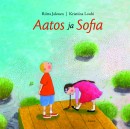 Aatos ja Sofia
Aatos ja Sofia
[Aatos and Sofia]
Kuvitus [ill. by]: Kristiina Louhi
Helsinki: Tammi, 2010. 36 p.
ISBN 978-951-31-5240-6
€14.30, hardback
Riitta Jalonen (born 1954) writes books for children and adults with the same emotional intensity. This picture book throws readers in alongside two children, Aatos and Sofia, to play in a sandpit. Aatos (or ‘Thought’, in Finnish) is a bit of a dreamer, while Sofia, who is slightly older, takes a more practical approach to life. As in her Tyttö (‘Girl’) trilogy, Riitta Jalonen uses an impressionistic mode of storytelling. Through a selection of brief, random scenes, Aatos ja Sofia tells the deeply personal story of a little boy’s fondness for his playmate. Kristiina Louhi’s bold, broad-brush illustrations have an almost hypnotic effect on the reader.
Translated by Ruth Urbom
Siri Kolu: Me Rosvolat [Me and the Robbersons]
27 January 2011 | Mini reviews, Reviews
 Me Rosvolat
Me Rosvolat
[Me and the Robbersons]
Kuvitus [ill. by]: Tuuli Juusela
Helsinki: Otava, 2010. 222 p.
ISBN 978-951-1-24393-9
€13.80, hardback
Me Rosvolat by Siri Kolu (born 1972), winner of the Finlandia Junior prize, is a clever combination of the spirit of the Norwegian children’s classic When the robbers came to Cardamom Town by Thorbjørn Egner and the fashionable road movie genre. A ramshackle gang of robbers kidnaps ten-year-old Vilja, who is in the middle of a holiday with her family. The Robbersons like to pounce, Robin Hood-like, on petty bourgeois types who ‘think they’re just regular people, but who’ve got plenty of nice things, like a car, good eats and clothes.’ In a carnival style that appeals to children’s sense of justice – and is reminiscent of Astrid Lindgren’s Pippi Longstocking – Kolu describes the Robberson family’s innocent-seeming raids on kiosks selling old-fashioned treats and the pick ‘n’ mix sections of video rental shops. Vilja and the Robberson family’s summer-long jaunt is filled with humour, sticky situations and thoughts on family relationships.
Translated by Ruth Urbom
Markus Majaluoma: Hulda kulta, luetaan iltasatu! [Hulda dear, let’s read a bedtime story!]
27 January 2011 | Mini reviews, Reviews
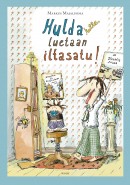 Hulda kulta, luetaan iltasatu!
Hulda kulta, luetaan iltasatu!
[Hulda dear, let’s read a bedtime story!]
Helsinki: WSOY, 2010. 24 p., ill.
ISBN 978-951-0-36284-6
€ 23.20, hardback
Since 1996, illustrator Markus Majaluoma (born 1961) has written and illustrated 17 children’s books. His picture books have been translated into six languages. In this, the third book of its series, Jalmari reads a bedtime story chosen by his strong-willed baby daughter Hulda – one that they’ve read a hundred times before, children being famously conservative in this regard. In the story, a wasp stings a bear. Jalmari falls asleep, but as clever little Hulda knows how the story ends, there will be a surprise for the snoring dad. The stripped-down little narrative is fleshed out with plenty of details in Majaluoma’s highly original illustrations (the wasp playfully stings with its snout) often standing in humorous counterpoint to the text, an amusing bonus for the adult reading it as a bedtime story.
Translated by Ruth Urbom
Finlandia Junior Prize 2010
26 November 2010 | In the news
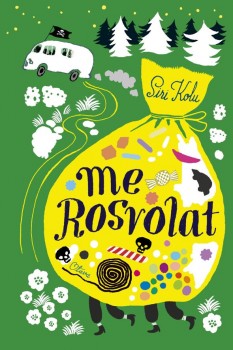 The Finlandia Junior Prize has gone to author Siri Kolu and illustrator Tuuli Juusela for the novel Me Rosvolat (‘Me and the Robbersons’, Otava); they will share the award of €30,000 (see the Prize jury assessments of the shortlist here). The winner was chosen by actor and writer Hannu-Pekka Björkman.
The Finlandia Junior Prize has gone to author Siri Kolu and illustrator Tuuli Juusela for the novel Me Rosvolat (‘Me and the Robbersons’, Otava); they will share the award of €30,000 (see the Prize jury assessments of the shortlist here). The winner was chosen by actor and writer Hannu-Pekka Björkman.
Awarding the prize on 25 November he said: ‘It caught my attention that in none of the six shortlisted children’s books are there any so-called nuclear families, at least not for long. The main characters constantly live and grow without something – the lack of parents or the attention of an adult is a serious matter to a child. However, in these books there is always someone who cares, not perhaps a stereotypical mom or dad, but an adult nevertheless.’ In Björkman’s opinion Me Rosvolat, with its rich language and a whiff of anarchy, presents the reader with moments of realisation and wonderment.
Book-giving time!
12 November 2010 | In the news
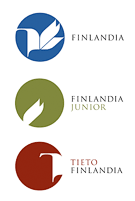 The few weeks before Christmas are when most books are bought in Finland, so shortlists of literary prizes start popping up in November.
The few weeks before Christmas are when most books are bought in Finland, so shortlists of literary prizes start popping up in November.
All the juries of the three biggest prizes – worth €30,000 each, awarded by the Finnish Book Foundation – have now published their shortlists: the Finlandia Prize for Non-Fiction, the Finlandia Junior Prize and the Finlandia Prize for Fiction.
The winners, each chosen by one person, will be announced in December. This FILI – Finnish Literature Exchange newsletter link will take you to the jury members’ assessments of the shortlisted non-fiction and Junior Prize works.
The following six novels ended up on the Finlandia Prize for Fiction list:
Joel Haahtela: Katoamispiste (‘Vanishing point’, Otava), Markus Nummi: Karkkipäivä (‘Candy day’, Otava), Riikka Pulkkinen: Totta (‘True’, Teos), Mikko Rimminen: Nenäpäivä (‘Nose day’, Teos), Alexandra Salmela: 27 eli kuolema tekee taiteilijan (’27 or death makes an artist’, Teos) and Erik Wahlström: Flugtämjaren (in Finnish translation, Kärpäsenkesyttäjä, ‘The fly tamer’, Schildts). Here’s the FILI link to the jury’s comments.
Hip hip hurray, Moomins!
22 October 2010 | This 'n' that
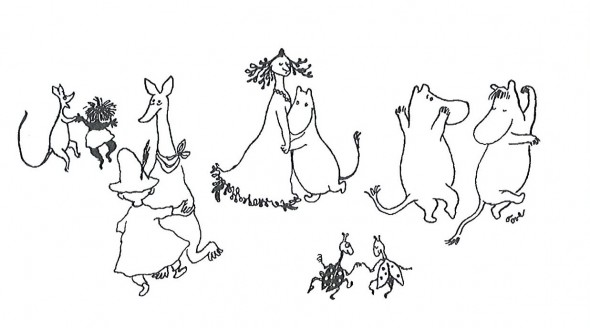
Partying in Moomin Valley: Moomintroll (second from right) dancing through the night with the Snork Maiden (from Tove Jansson’s second Moomin book, Kometjakten, Comet in Moominland, 1946)
The Moomins, those sympathetic, rotund white creatures, and their friends in Moomin Valley celebrate their 65th birthday in 2010.
Tove Jansson published her first illustrated Moomin book, Småtrollen och den stora översvämningen (‘The little trolls and the big flood’) in 1945. In the 1950s the inhabitants of Moomin Valley became increasingly popular both in Finland and abroad, and translations began to appear – as did the first Moomin merchandise in the shops.
Jansson later confessed that she eventually had begun to hate her troll – but luckily she managed to revise her writing, and the Moomin books became more serious and philosophical, yet retaining their delicious humour and mild anarchism. The last of the nine storybooks, Moominvalley in November, appeared in 1970, after which Jansson wrote novels and short stories for adults.
Tove Jansson (1914–2001) was a painter, caricaturist, comic strip artist, illustrator and author of books for both children and adults. Her Moomin comic strips were published in the daily paper the London Evening News between 1954 and 1974; from 1960 onwards the strips were written and illustrated by Tove’s brother Lars Jansson (1926–2000).
Tove’s niece, Sophia Jansson (born 1962) now runs Moomin Characters Ltd as its artistic director and majority shareholder. (The company’s latest turnover was 3,6 million euros).
For the ever-growing fandom of Jansson there is a delightful biography of Tove (click ‘English’) and her family on the site, complete with pictures, video clips and texts.
The world now knows Moomins; the books have been translated into 40 languages. The London Children’s Film Festival in October 2010 featured the film Moomins and the Comet Chase in 3D, with a soundtrack by the Icelandic artist Björk. An exhibition celebrating 65 years of the Moomins (from 23 October to 15 January 2011) at the Bury Art Gallery in Greater Manchester presented Jansson’s illustrations of Moominvalley and its inhabitants.
In association with several commercial partners in the Nordic countries Moomin Characters launched a year-long campaign collecting funds to be donated to the World Wildlife Foundation for the protection of the Baltic Sea. Tove Jansson lived by the Baltic all her life – she spent most of her summers on a small barren island called Klovharu – and the sea featured strongly in her books for both children and adults.

